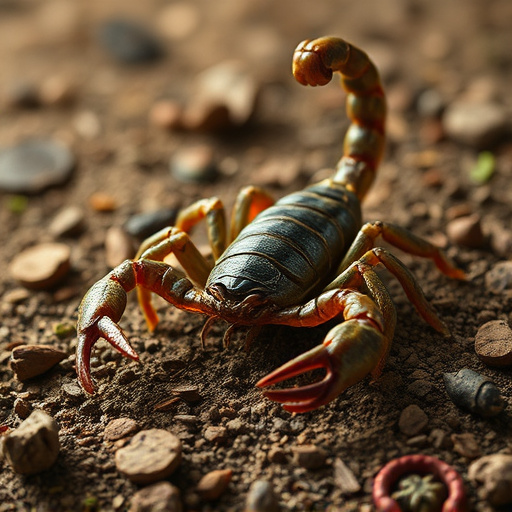The Catalina Foothills near Tucson, Arizona, support a diverse desert ecosystem, including scorpions like the bark scorpion and mountain scorpion. These scorpions have adapted to extreme temperatures, limited water, and sparse food through burrowing and specialized metabolism. Effective scorpion control Tucson requires understanding these adaptations, habitat preferences, and behaviors. The local climate, rock formations, and creosote bushes provide ideal habitats. Coexistence with humans is possible through eco-friendly pest control services and homeowner precautions like sealing entry points and proper lighting. Preserving the desert ecosystem's balance ensures scorpion survival and biodiversity without relying on harsh chemicals.
In the arid landscapes of Catalina Foothills, desert scorpions have adapted to thrive amidst the rugged terrain. This article delves into the intricate relationship between these arachnids and their unique ecosystem. We explore the diverse scorpion species inhabiting Tucson’s surroundings, factoring in environmental conditions that shape their survival. Understanding human-scorpion interactions is key, especially for effective scorpion control in Tucson. Moreover, we discuss conservation strategies to maintain a delicate balance in these desert environments, promoting peaceful coexistence.
- Understanding Catalina Foothills' Desert Ecosystem
- Scorpion Species Found in Tucson's Surroundings
- Factors Influencing Scorpion Habitat and Survival
- Human-Scorpion Interaction and Control Methods
- Conserving the Desert Balance: Coexistence Strategies
Understanding Catalina Foothills' Desert Ecosystem

The Catalina Foothills, located in Tucson, Arizona, boast a unique desert ecosystem that provides an intriguing habitat for various species, including scorpions. This rugged terrain is characterized by a blend of sandy washes, rocky outcrops, and sparse vegetation, creating a challenging yet vibrant environment. Understanding this landscape is key to comprehending how scorpions adapt and thrive in the region, which offers insights into effective scorpion control Tucson methods.
The desert ecosystem’s extreme temperatures, limited water sources, and sparse food supply present significant challenges for most organisms. Yet, scorpions have evolved remarkable strategies to survive these conditions. They burrow deep into the ground during the hottest parts of the day to escape heat stress and remain active at night when temperatures are more tolerable. This adaptation ensures they can hunt effectively and conserve energy in the harsh desert environment.
Scorpion Species Found in Tucson's Surroundings

In the diverse landscape of Catalina Foothills, a variety of scorpion species have adapted and thrive in the region’s arid desert environments. Among them, the most common types include the bark scorpion (Crotalus cerastinus) and the mountain scorpion (Androctonus australis). These scorpions are well-equipped to handle the extreme conditions of the desert, with their ability to burrow for shelter and a unique metabolism that allows them to survive on minimal water.
Tucson and its surroundings serve as an ideal habitat for these arachnids due to the region’s consistent climate and abundance of rock formations and creosote bushes—favorite hiding spots for scorpions. While not inherently aggressive, these species have powerful stings and play a crucial role in maintaining ecological balance. For those concerned about scorpion control Tucson, understanding the local species and their behaviors is essential.
Factors Influencing Scorpion Habitat and Survival

The habitat and survival of scorpions in Catalina Foothills’ desert environments are shaped by a complex interplay of factors. One of the most significant influences is temperature, with scorpions preferring warm days and cool nights, ideal for their metabolic processes and avoiding excessive dehydration. This region’s arid climate provides just the right conditions, allowing them to thrive under the scorching sun during the day and seeking shelter in rock crevices or beneath organic matter at night.
Prey availability also plays a crucial role in scorpion survival. These desert inhabitants are opportunistic predators, feasting on insects, arachnids, and even small vertebrates. The diverse ecosystem of Catalina Foothills offers an ample food supply, ensuring their populations remain robust. Moreover, the type of soil and vegetation can impact scorpion distribution; they often inhabit areas with sandy or rocky soils that provide easy burrowing opportunities for escape from extreme temperatures and to ambush prey. Understanding these factors is essential for effective scorpion control in Tucson, as it informs strategies to manage their presence while preserving the delicate balance of the local desert ecosystem.
Human-Scorpion Interaction and Control Methods

In the Catalina Foothills’ desert landscapes, humans and scorpions often share spaces, leading to potential interactions that can range from curiosity to conflict. Scorpions are naturally adaptive creatures, thriving in various environments, including urban areas. As development encroaches on desert regions, human-scorpion encounters become more common. Understanding these interactions is key to maintaining a harmonious coexistence.
Scorpion control in Tucson and the surrounding areas involves a combination of prevention and management strategies. Regular pest control services offer specialized treatments for scorpion infestations, employing eco-friendly methods to minimize impact on non-target species. Homeowners can also implement simple precautions like sealing entry points, maintaining proper lighting (as scorpions are attracted to darkness), and keeping yards neat and free of debris. Education is a powerful tool; knowing the behavior and preferences of local scorpion species helps residents avoid disturbances and reduce the need for invasive control measures.
Conserving the Desert Balance: Coexistence Strategies

The delicate balance of desert ecosystems, like those found in Catalina Foothills, requires a careful interplay between various species. Scorpions, as both predators and prey, play a crucial role in maintaining this equilibrium. Understanding their habitat preferences and survival strategies is essential for implementing effective scorpion control Tucson methods that preserve the overall health of the ecosystem.
In these arid environments, scorpions have developed unique adaptations to cope with extreme temperatures and limited resources. They tend to bury themselves in the sand during the hottest parts of the day, emerging at night when temperatures are cooler to hunt for food. By coexisting harmoniously, scorpions contribute to natural pest control, helping to regulate insect populations without the need for harsh chemical interventions. Protecting this balance ensures the survival not only of scorpions but also of other desert inhabitants, ultimately enriching the biodiversity of Catalina Foothills’s unique landscape.
The diverse desert ecosystems of Catalina Foothills provide a unique habitat for various scorpion species thriving in Tucson’s surroundings. Understanding these intricate relationships is crucial for effective scorpion control Tucson methods. By recognizing the factors that influence their survival, from climate variations to human interactions, we can develop sustainable coexistence strategies. Conserving the delicate balance of this vibrant desert landscape ensures both the well-being of native wildlife and a safe environment for locals and visitors alike.
